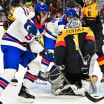NHL.com is providing in-depth analysis for each of its 30 teams throughout August. Today, the biggest reasons for optimism and the biggest questions facing the Carolina Hurricanes.
As with any team in a rebuild, the Carolina Hurricanes are somewhere along the path to future success -- but it's difficult to determine exactly where with them.
After a 15-point improvement from 2014-15, the Hurricanes hope to continue their ascent this season. The next step involves revamping the offense. To make it happen, they parted ways with six forwards from last season and brought in established players who will have a chance to play key roles. The key question is: Will the newcomers make the Hurricanes a better team?
Reasons for optimism, questions facing Hurricanes
Youthful defense, forwards Victor Rask, Jeff Skinner aiming for next level

© Gregg Forwerck/Getty Images
By
Kurt Dusterberg
NHL.com Independent Correspondent
Hurricanes 30 in 30: Season outlook | Top prospects | Fantasy outlook
Here are four reasons for optimism entering this season:
1. The young defense has a bright future
Just how good is Carolina's young defense? All the talk last season was about Jaccob Slavin (22), Brett Pesce (21) and Noah Hanifin (19). Their rookie season overshadowed the continued development of two-time NHL all-star Justin Faulk, who is 24.
All three second-year defensemen are at least 6-foot-2, skate well and play with veteran poise. The key for each will be avoiding a regression when asked to take on a greater role.
Veteran defensemen Ron Hainsey and John-Michael Liles helped mentor the rookies last season. Hainsey will be back, but Liles was traded to and re-signed with the Boston Bruins. The Hurricanes might try to acquire an established defenseman before the start of the season to mentor the young group.
2. Victor Rask's scoring touch
Rask jumped from 11 goals as a rookie to 21 last season, when he was tied for second on Carolina with 48 points in 80 games. The Hurricanes rewarded the 23-year-old center with a six-year, $24 million contract.
Rask may be just scratching the surface on his scoring potential. He's a good puck-handler and has a deft touch in close, but he also scores a lot of goals by driving the net for deflections and rebounds. With the right linemates, he could score 30 goals.
Rask's emergence as a scoring threat gives the Hurricanes another viable center, along with Jordan Staal, to handle top-six duties. Rask played with Jeff Skinner (28 goals) during the latter half of the season, establishing a strong chemistry.
3. Jeff Skinner has grown his game
With two NHL seasons with more than 30 goals and two with 20 or more, including 28 last season, it's easy to forget Skinner is 24 years old. The left wing is a streaky scorer -- he had nine goals in six games in December -- but he remains the Hurricanes' most dynamic offensive player. The additions of forwards Lee Stempniak and Teuvo Teravainen should help Skinner maintain his offensive production.
Last season, Skinner took a step forward in his development, becoming a more effective defensive player. He stripped pucks in the neutral zone and relied on speed and sound positioning to help the transition game. His minus-2 rating was a 22-point improvement from the previous season.
4. They've bought in to coach Bill Peters' system
The Hurricanes' 15-point improvement from Peters' first season to his second is evidence they understand the program. For his efforts, Peters was rewarded with a contract extension through 2018-19.
In 2014-15, Peters often lamented after losses that the Hurricanes didn't "start on time." Those occasions were rare last season, with Carolina mastering the details of his system, whether by making short, quick passes out of the defensive zone or playing with pace to pressure opposing defensemen.
The makeover was not only philosophical. Carolina has parted ways with 17 lineup mainstays over the past two seasons. Now with new players suited to his mission, Peters wants to deliver.
"The team is getting younger and I'm getting older," Peters said. "I just like the direction we're headed in, and we're headed in that direction for a long time."
Here are three key questions facing the Hurricanes:
1. Will there be enough scoring?
Carolina was 27th in the NHL in scoring each of the past two seasons (2.39 goals per game last season; 2.23 in 2014-15), not an easy problem to fix under any circumstances. But the Hurricanes are building for the next decade rather than just next season. Swinging for the fences was not an option.
"Does it makes sense to give a 32- or 33-year-old a six-year contract for a lot of money?" general manager Ron Francis asked. "It probably doesn't fit with what we're trying to build."
So the Hurricanes made a series of sensible acquisitions, hoping for more productivity from a new mix. Stempniak (19 goals last season with the New Jersey Devils and Boston Bruins) and Teravainen (13 goals with the Chicago Blackhawks) effectively replace departed top-six forwards Eric Staal (10 goals before being traded to the New York Rangers) and Kris Versteeg (11 goals before being traded to the Los Angeles Kings).
To challenge for the Stanley Cup Playoffs, the Hurricanes will need to add more forwards who can score 20 or so goals. Management has addressed the need for more skill, but the offense would benefit from more net-front presence to bolster scoring as well.
2. Will the goaltending improve?
When Cam Ward met with media after last season, it appeared to be the final time as a member of the Hurricanes. Francis made it clear he would pursue other options in the offseason, just as he had sought to trade Ward the previous summer.
But Ward was re-signed for two years, leaving Carolina in the same goaltending situation as last season, with Eddie Lack serving as Ward's backup. Together, they combined for a .902 save percentage.
Francis believes Ward earned the contract with a strong second half last season, but the 32-year-old's career averages over 11 NHL seasons (2.70 goals-against average, .910 SV%) would not be among the League's top goaltenders.
Lack was a disappointment last season after two promising seasons with the Vancouver Canucks. If the Hurricanes are to improve, the goaltending must be substantially better.
3. Who will emerge as Carolina's leader?
Eric Staal was Hurricanes captain for seven seasons until he was traded to the Rangers prior to the 2016 NHL Trade Deadline. Naming the next Carolina captain will be as important as any decision since Francis took over as GM and Peters was named coach two years ago.
For a team without a winning culture, the captain will be more than just a symbolic role. There is no obvious choice on the roster. The Hurricanes have had a quiet locker room for several years. With so many young players, they would benefit from coalescing around an outgoing, vocal veteran with the competitive fire Peters embraces.
Francis and Peters have said they are content going without a captain and using a group of alternates until a clear-cut leader emerges.

















